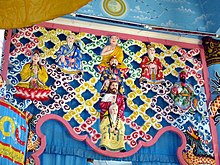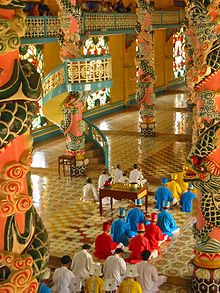Caodaism

Caodaism ( Vietnamese : Đạo Cao Đài , Chữ Nôm : 道 高 臺 ) is a religion officially founded on September 7, 1926 in southern Vietnam . The estimates of the number of followers vary widely, with the majority giving two to three million, but other sources eight million believers in Vietnam. After Buddhism and Catholicism , it is the third largest religion in the country, just ahead of Hòa Hảo and Protestantism . There are approximately 30,000 Caodaists in the United States, Europe, and Australia through emigration.
The revelation of this religion, received through spiritualistic sessions, contains a comprehensive syncretism of Asian and Christian beliefs.
Benefactor
The founder of the religion is Ngô Văn Chiêu (1878–1932), who learned about the revelation of the god Cao Đài on December 25, 1925. A member of the colonial council, Lê Văn Trung (1876–1934), a well-known living man and opium smoker, should be entrusted as the leader of this new religious community . This changed his way of life to asceticism .
history
In Cochinchina there was a tradition of Buddhist millennialism even before the colonization by France, which often articulated the social tension between urban landowners and the often landless peasantry in times of crisis. This was expressed in social religious movements as well as in uprisings and the attempt to set up a religious state against the monarchical order. Under French colonial rule, the population in Cochinchina increased from 1.7 million in 1880 to 4.4 million in 1930. From 1911 to 1913, the mystic Phan Xich Long led a religious rebellion against French rule, which was suppressed by the colonial power.
Caodaism emerged from the confrontation with colonialism and assigned it the metaphysical meaning of a punishment for neglecting divine principles. The organizational structure was modeled on religious leader Le Van Trung of the Catholic Church. The Caodaists formed a church with an organized, hierarchically structured clergy which is directed by a Pope based in the province of Thay Ninh. The Caodaists developed a social doctrine which corresponded to the Buddhist reform movements of the time. She called for a new regulation of the relations between farmers and landowners as well as an increased equality of the female part of the population. The religion spread rapidly in Cochinchina shortly after its inception, encompassing around 10% of the population there.
After Trung's death in 1935, a former official of the colonial state Phạm Công Tắc took over the leadership of the movement. After the defeat of France in the western campaign in 1940 and the collaboration with the Japanese by the Vichy-loyal colonial authorities in Cochinchine, the Caodaists were able to expand their influence and, with Japanese help, formed armed militias. Fearing a rebellion, Phạm Công Tắc was arrested by the colonial authorities and exiled to Madagascar .
Syncretism
In the course of history, God, indirectly referred to as Cao Đài ("high altar"), is said to have made several revelations known , such as for Christianity :
and for the Asian religions:
- the sublime Laozi (Lão Tử) had the merit of participating in the salvation of humanity,
- the wise Confucius (Khổng Tử) clearly indicated the path of the right mediocrity,
- the merciful Buddha (Phật) preached humility and charity,
to finally complete everything with Caodaism.
Teaching and cult
Caodaism teaches the transmigration of souls and holds moral principles such as vegetarianism , alcohol prohibition, selflessness , charity and poverty as a moral duty. The cult is performed in richly decorated temples with incense, evocations and prayers. Among the "high spirits" of Caodaism are u. a. Sun Yat Sen , Isaac Newton , the Maid of Orleans and Victor Hugo , to show their importance to humanity.
hierarchy
The hierarchy is based on the model of the Catholic Church with the following offices or degrees: Ðạo hữu (believer), Chuc viec ( subordinate dignitary ), Lễ Sanh (priestly student ), Giáo Hữu ( priest ), Giáo Sư ( bishop ), Phối Sư ( Archbishop ), Ðầu Sư ( Cardinal ), Chưởng Pháp (Censor Cardinal) and Giáo Tông (Hán nôm: 敎 宗 , " Pope ").
There are three censor and ordinary cardinals, 36 archbishops and 72 bishops. Ngô Văn Chiêu was the only Cao Đài pope to date, the post has been vacant since 1932 . Due to restrictions on the part of the Vietnamese government, the Cao Đài followers are not allowed to appoint a new Pope or hold spiritualistic meetings.
literature
- Phan-Long Nguyên: Caodaism: the mysticism of God Cao-Dài ( Memento of July 5, 2010 in the Internet Archive ). Association of CaoDaists in the Federal Republic of Germany, Munich 1991 (PDF; 362 kB)
- Victor L. Oliver: Caodai spiritism: A study of religion in Vietnamese society. Foreword by Pierre Rondot. Brill, Leiden: 1976, ISBN 90-04-04547-3
- Jayne Susan Werner: Peasant Politics and Religious Sectarianism: Peasant and Priest in the Cao Dai in Viet Nam. Southeast Asian Studies. Yale University, New Haven 1981, ISBN 978-0-938692-07-2
Web links
- caodai.org (English / Tiếng Việt)
- Sydney Center for Studies in Caodaism
- caodai-europe.info (Cao Dai texts, French)
Individual evidence
-
^ Religion distribution according to OHCHR ( Press Statement on the visit to the Socialist Republic of Viet Nam by the Special Rapporteur on freedom of religion or belief ): 11 million Buddhists, 6.2 million Catholics, 1.4 million Protestants, 4.4 million Cao Dai followers, 1.3 million Hoa Hao Buddhists (July 31, 2014).
In contrast, CIA World Factbook : Vietnam : Buddhist 7.9%, Catholic 6.6%, Hoa Hao 1.7%, Cao Dai 0.9%, Protestant 0.9% (2009 estimate) - ↑ a b c Christopher Goscha: Vietnam - A New History. New York, 2016 p. 174f
- ^ Michael Leifer: Dictionary of the modern politics of South-East Asia . Routledge, London 1996, ISBN 0-415-13821-3 . Article "Cao Dai (Vietnam)"


